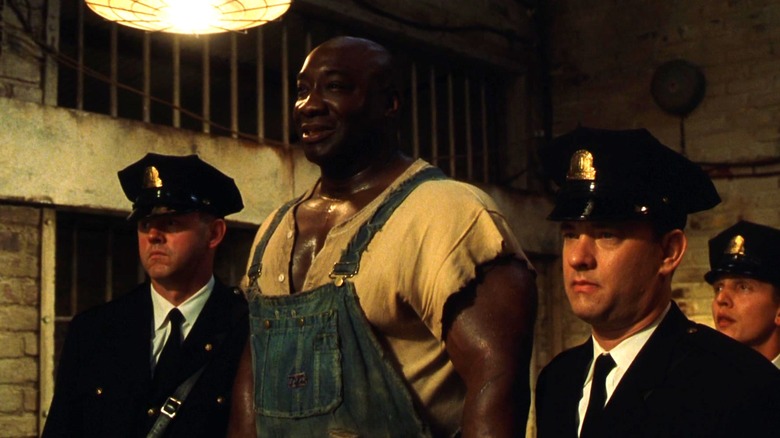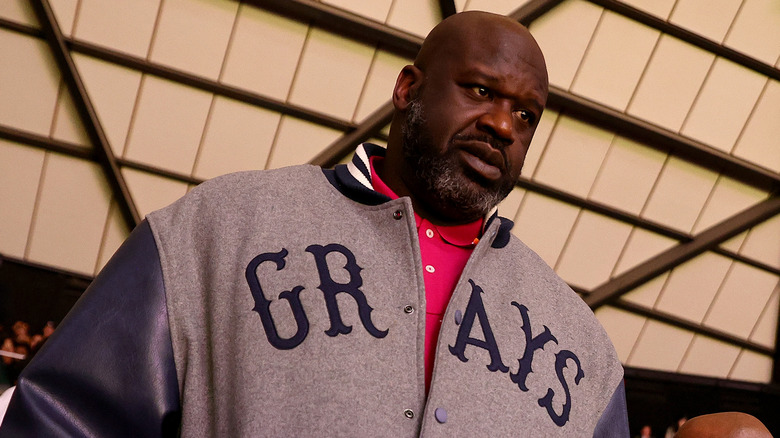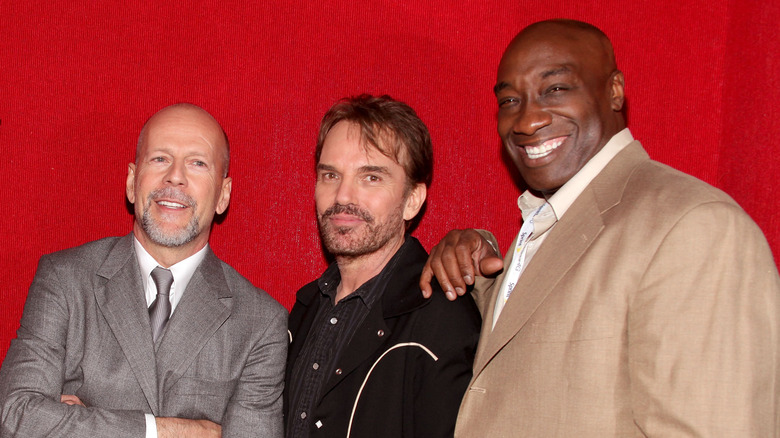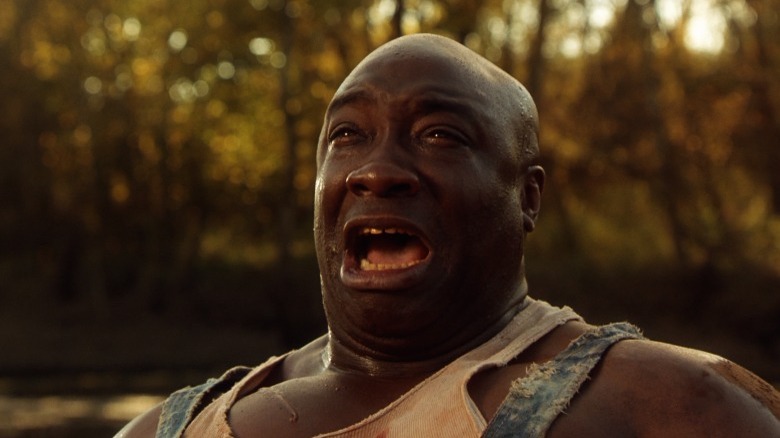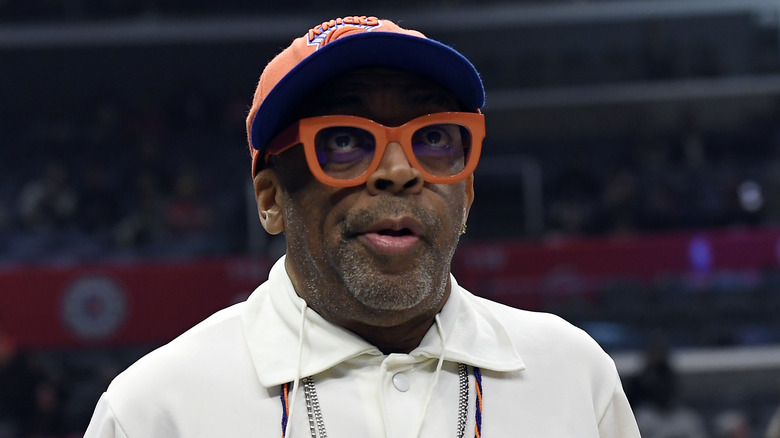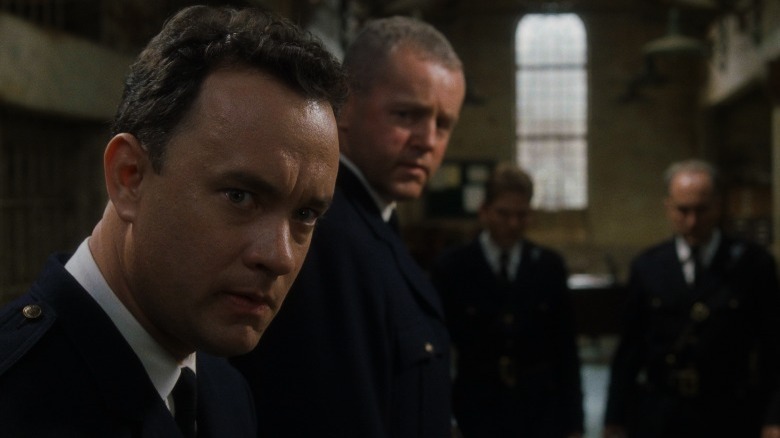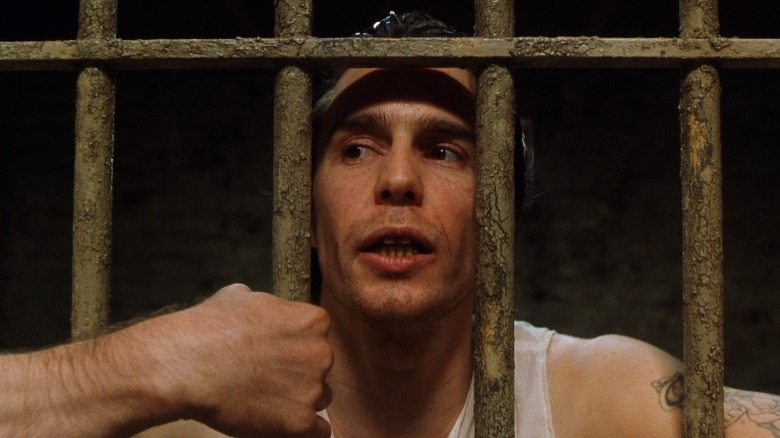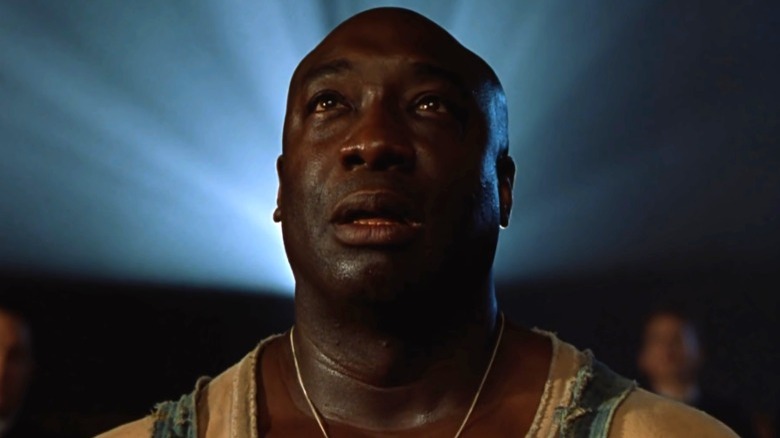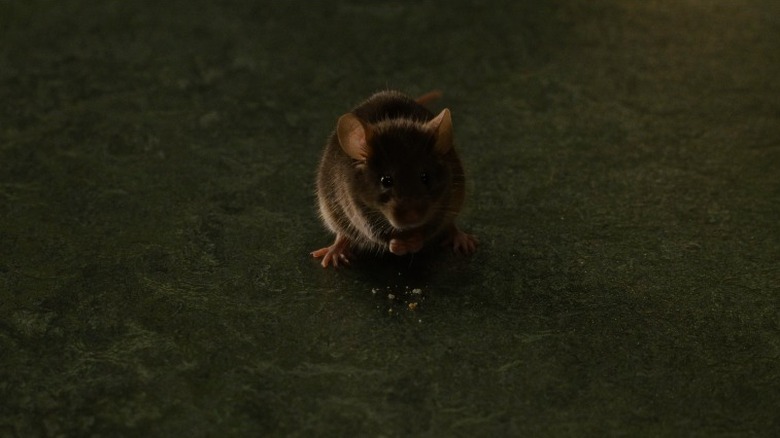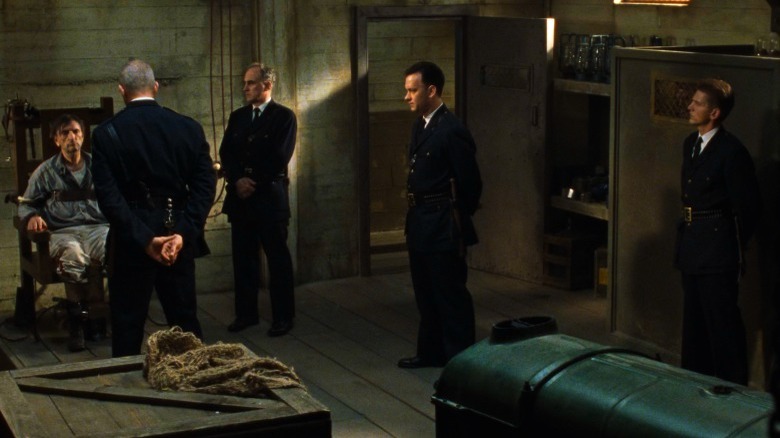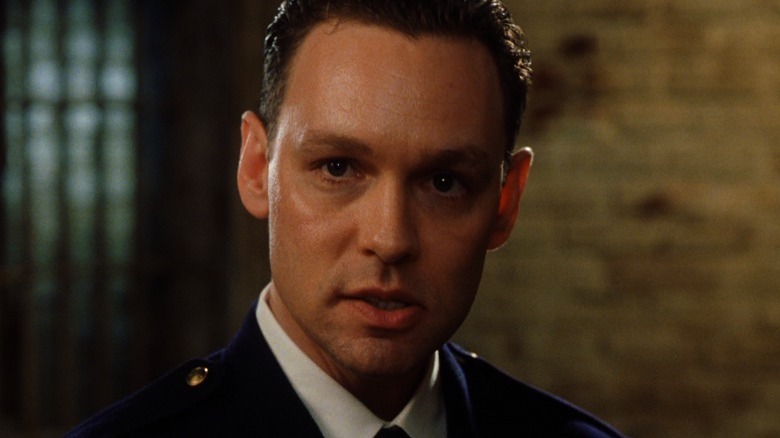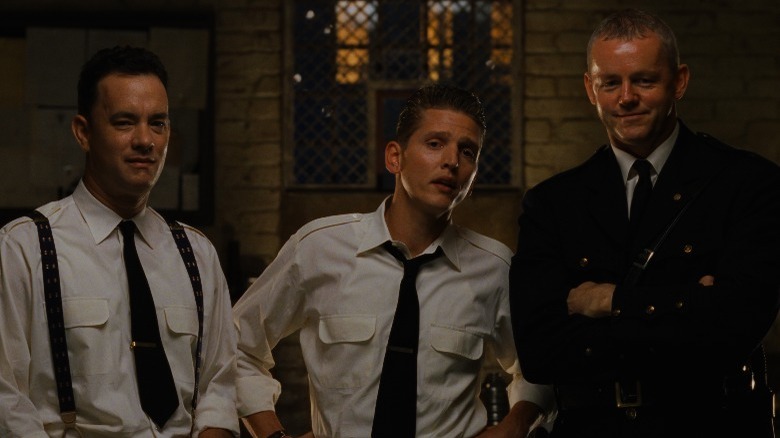The Green Mile Facts That Are Still Behind Bars
Less than a month before the bloodiest but most innovative century humanity has ever known ended, a film was released that seemed to encapsulate the madness, miracles, murder, and magic of the previous 100 years in just three hours. Based on Stephen King's novel serialization of the same name and directed by Frank Darabont, "The Green Mile" tackled some big themes and asked some tricky questions.
"The Green Mile" exists in an old bluesman's version of America where good men are morally conflicted, bad men roam the roads, racism is rife, corruption is commonplace, innocent men are executed, justice hides her eyes, the devil makes deals at the crossroads, and angels walk amongst us. "The Green Mile" is set during the Great Depression and tells the story of John Coffey, a man whose skin color, physical presence, social standing, lack of guile, and child-like nature make him an easy victim in a world gone wrong.
Through the plight of Coffey, the viewer is forced to confront the nature of racism, evil, capital punishment, redemption, and the possibilities of miracles in the unlikeliest places. Here are some facts about "The Green Mile" you might not know.
Shaquille O'Neal said he turned down the role of John Coffey
When the viewer meets John Coffey (Michael Clarke Duncan), the most noticeable thing about the man is his sheer size. Wrapped in chains and staring silently into some distant land only he can see, Coffey towers over prison guards Paul Edgecomb (Tom Hanks) and Brutus "Brutal" Howell (David Morse). At six foot five, Duncan only had four inches on Hanks and one on Morse, but through camera trickery and Duncan's immense and impressive physicality, he looks a lot bigger — particularly when Hanks asks, "I'm not going to have any trouble with you am I big boy?"
The role of Coffey demanded the role of a big person and personality, and during a chat with The Marchand and Ourand Sports Media Podcast, Shaquille O'Neal revealed he'd been given a chance to step into Coffey's shoes on "The Green Mile" but turned it down because "I didn't want to play the down south African-American guy during slavery. I didn't want to play that role."
O'Neal adds that his decision was validated when he saw the powerhouse performance that Duncan produced for the role and said, "He did way better than I could have done."
Bruce Willis recommended Michael Clarke Duncan for the part
Playing John Coffey in "The Green Mile" was Michael Clarke Duncan's breakthrough role and the one for which the actor, who tragically passed away from a heart attack in 2012 at age 54, is best remembered. The part could have easily descended into caricature or pantomime, but Duncan keeps things restrained, subtle, and emotive enough to stay authentic and even earn himself an Academy Award nomination. As a former bodyguard whose clients included The Notorious B.I.G., Duncan revealed in an interview with Notorious Online that he gave up working in security after the late rapper was fatally gunned down. He explained, "I was supposed to be with him the night he was killed. In fact, a friend of mine, we switched about two hours before because he wanted me to be with Babyface." Duncan revealed he viewed Notorious's death as a wake-up call and decided to concentrate on acting.
Appearing as Bear in "Armageddon" proved his lucky break. His co-star Bruce Willis subsequently recommend him for the role of Coffey. In the documentary, "Walking The Mile: The Making of The Green Mile," Frank Darabont explained, "Willis had read these books and called and said, 'I got the guy who's gonna be your John Coffey, Michael Clarke Duncan, you gotta have him in to read.'" Duncan said his first audition wasn't all that good but Darabont couldn't get him out of his mind. When the director brought him in again for another try, the world finally got a taste of what Duncan could do.
Duncan channeled childhood hurt for the part of John Coffey
John Coffey is a hyper-sensitive soul who feels the suffering and pain people inflict upon one another. His gift of pure empathy means he absorbs hurt like a sponge and his ability to heal others is, in many ways, a curse because he has no off switch. Coffey is haunted by the collective history of humanity's inhumanity and is condemned to carry that terrible weight upon his broad shoulders. Playing such a character was always going to be emotionally challenging and draining, and in "Walking the Mile: The Making of The Green Mile," Michael Clarke Duncan credited acting coach Larry Moss with helping him to tap into the reservoirs of pain needed to play such a wounded and vulnerable character.
Moss advised Duncan that he'd have to find his inner five-year-old if he wanted to do justice to the character of Coffey because that was the mental age of the character. Moss told Duncan, "Tell me anything you can remember about growing up in Chicago, with your sister and your mother, with that kind of poverty, and no matter how painful it is I want you to tell me."
Moss revealed that an emotional Duncan told him some real horror stories and knew if he could channel that sort of hurt, he would own the part. Moss explained that during a subsequent screen test, they did a close-up of Duncan's face, and "In his eyes was the pain of the world, he had found that in himself. And the camera doesn't lie that close."
Spike Lee slammed The Green Mile for its use of a magical Black character
"The Green Mile" is, amongst other things, a film that strives to highlight how racism diminishes the world and everyone in it. John Coffey is an innocent man but because he was caught at the scene of the crime clutching two murdered girls and howling like a man possessed, he's assumed guilty, in part, because of the color of his skin. Even Coffey's defense lawyer likens him to a friendly dog who one day oversteps the mark and goes feral. When the guards realize his innocence and that "Wild Bill" Wharton (Sam Rockwell) was responsible for the slayings, there's no optimism he'll escape the chair. The evidence is stacked against him and he remains a black man in a white man's world.
Director Spike Lee had a different take and slammed the role of Coffey as a black stereotype. During a talk to students at Yale's Calhoun College, Lee explained that Coffey was simply part of the latest trend in movies to feature an African- American with otherworldly gifts. He described Coffey as the same "magical, mystical Negro" character that also appears in films such as "The Legend of Bagger Vance," "What Dreams May Come," and "The Family Man."
Lee then asked, "How is it that black people have these powers but they use them for the benefit of white people?" The director said he believed such portrayals were dangerous because they were recycling caricatures of the "noble savage" and the "happy slave."
Tom Hanks admits The Green Mile played hard and fast with historical fact
A stint in Cold Mountain Penitentiary's death row doesn't look enjoyable, but according to Tom Hanks things could have seemed a lot harsher if "The Green Mile" hadn't played so hard and fast with historical fact. In an interview with Entertainment Weekly, Hanks explained that he refused to visit an actual prison before shooting "The Green Mile" in case it ruined his confidence in the script, particularly the kindness with which most of the guards treat the prisoners. He also pointed out that death row guards in 1935 didn't wear uniforms and probably didn't carry sidearms in case the inmates got their hands on them.
However, the biggest historical discrepancy in "The Green Mile" by a country mile is that the electric chair wasn't a fixture in Louisiana until 1940. In 1935, hanging was the preferred choice of execution. The first legal electric chair execution in Louisiana took place on September 11, 1941. Even stranger — due to state laws that specified executions could only be held in the county where the crime took place — the electric chair was housed in the back of a specially converted van, as explained by the Angloa Museum.
Capital punishment has divided opinion for decades. Some see it as an instrument of righteous vengeance, others an affront to all that is good and forgiving in human nature. After watching Eduard "Del" Delacroix's (Michael Jeter) botched execution in "The Green Mile," there can be no doubt that the taking of life, even in the name of justice, always has consequences and leaves an unmistakable mark on everyone who bears witness.
Sam Rockwell was warned the world would remember Wild Bill Wharton
The Great Depression was a defining period in American history and "The Green Mile" attempts to capture the bleakness, darkness, and lack of optimism that covered the land. In the face of mass unemployment, hunger, and homelessness, many turned to a life of crime to make ends meet. On a very superficial level, Sam Rockwell's character "Wild Bill" Wharton is a rambling itinerant cut from the same cloth as criminal opportunists such as John Dillinger, Pretty Boy Floyd, and Machine Gun Kelly.
However, "Wild Bill" isn't some outlaw that can be romanticized as an individual who turned to a life of crime to beat the system. He's a cold-blooded villain who has no saving grace and is riddled with a chaotic but very intense evil. In an interview at the Santa Barbara International Film Festival, Rockwell revealed that he was reluctant to wear false teeth for the role but was told by Bonnie Hunt, who plays Jan Edgecomb, that because Wharton was so twisted and vile, the audience is "not going to forget this character."
Rockwell explained that he thought it would be sensible to wear the fake teeth, "Because I need a disguise. This guy's going to be around for a little bit."
Frank Darabont wanted The Green Mile to show the better angels of our nature
Apart from "Wild Bill" Wharton and Percy Wetmore, nearly every other character in "The Green Mile" contains an element of goodness in their nature. The prison wardens may be responsible for keeping hardened criminals and dangerous men safely under lock and key but they treat them with kindness and respect as they inch ever nearer to their date with death. Even convicts such as Eduard Delacroix are shown to be capable of compassion and great affection through the care of his pet mouse Mr. Jingles. Then there is John Coffey, who has been chained, taunted, imprisoned, and sentenced to death for a crime he had no hand in. Yet instead of being consumed by rage at the rank injustice of it all, he remains calm and forgiving while using his special powers for the benefit of others until the bitter end.
In an interview with Creative Screenwriting, Darabont explained that it was important for Coffey to have "a purity of soul" but admits, "It's always hard to write a hero, and it's hard to write a hero who stays a hero." The director added he's always been fascinated by characters whose journey entails them moving out of the shadows in search of enlightenment. He explained, "I want more movies showing us the potential of ourselves. People seeking what Abraham Lincoln called, 'the better angels of our nature,' rather than necessarily being mired in all the ways in which we can fail — spiritually or emotionally."
Over 30 mice were used for the role of Mr. Jingles
One of the true stars of "The Green Mile" walks on four legs, has a tail, a fondness for cheese, and whose dialogue consists of little more than squeaking. Mr. Jingles is the circus mouse who wins over the hearts of both the guards and convicts in Cold Mountain Penitentiary's death row with his fearless inquisitiveness, curious intelligence, and entertaining tricks. His bond with John Coffey grants him an incredibly long life and his friendship with Eduard Delacroix helps the condemned men face his execution. The little rodent is central to the plot — but the part didn't just fall to one mouse!
Acting is strenuous work for a human and its toll is even more exacting when you're a mouse. According to No Animals Were Harmed, more than 30 mice were trained to feature in the movie. The mice performed everything that was asked of them with the help of several trainers who were located off-camera to encourage their super furry little prodigies to take things to the next level.
Tom Hanks describes The Green Mile as his best ensemble experience
One of the reasons "The Green Mile" works so well as a movie is thanks to its talented team of actors. The chemistry they enjoy is evident as they encourage one another to climb to new and greater heights in their performance. Egos were all left at the doors as everyone involved concentrated on ensuring the movie conjured up a rare kind of magic. In the documentary "Walking the Mile: The Making of The Green Mile," Frank Darabont explained, "People do say casting is half the battle. I say casting is all the battle," and added that once again he was pretty fortunate to capture "lightning in a bottle" with the casting for "The Green Mile."
Tom Hanks said, "The power of being in this particular ensemble was very unique." He explained that although a lot of his previous roles had been "guy-centric," the ensemble experience he enjoyed on "The Green Mile" exceeded them all and was by far the most memorable. He said, "There was a bona fide affection for one another. A very disparate group of individuals but there was some strange coagulation of desires and talents on this thing where we would come out of our trailers when we weren't in the scene to watch what someone was doing."
Percy Wetmore was Doug Hutchinson's all-time favorite role
Although "Wild Bill" Wharton easily steals the honors as the most repulsive and repugnant character in "The Green Mile," Percy Wetmore is a close second. The mouse stomping, execution sabotaging, and prisoner baiting Wetmore is the sort of insidious and spineless weasel who doesn't so much walk but slither.
Wetmore is not so much the bully but the vastly more dangerous bully's sidekick. He's the nephew of the state governor's wife, and he exploits that connection ruthlessly as he hunts down opportunities to indulge his deep-rooted sadistic streak. Wetmore thinks his privilege makes him untouchable and has the sort of brazen arrogance and contempt that life has a habit of slapping down hard at the most unexpected moment.
Dough Hutchinson is on fire as Wetmore and musters up a performance that is a half-Southern gentleman and half-devil incarnate. It's little wonder that in an interview with Wiki 24, the actor cites Wetmore as his all-time favorite role. Hutchinson admits he loves the opportunities character acting presents to strut his stuff and wear a wealth of masks but adds, "If I was typecast as 'the bad guy' for the remainder of my career, I'd be a happy camper. The villains are always the juiciest parts to play." In an interview with Creative Screenwriting, Frank Darabont said, "There's always going to be a Percy, somebody in some position of power, even minimal power, who lacks the reason and compassion to be a person."
Frank Darabont isn't sure what The Green Mile is about
Although set largely in the grim confines of death row, "The Green Mile" offers the viewer horizons of unlimited possibilities. It's a movie where the viewer's imagination can fill in a lot of empty spaces. Nothing is set in stone and by the time the end credits roll we're no wiser as to the true nature of John Coffey — where he came from and how he came to be that way remains a mystery. Neither do we know exactly how long Paul Edgecomb will continue to walk the earth, forever haunted by events of another lifetime. "The Green Mile" is brushed by shades of darkness and light, miracles and murder, duty and sacrifice, crime and punishment, and the neverending dance between good and evil. Like all good works of art, its exact meaning is as open-ended as the highway and as deep as the ocean.
In an interview with Creative Screenwriting, Frank Darabont explained he saw John Coffey as a Christ-like figure and said, "I do believe that on a thematic level this is about Christ being crucified and the guys who have to crucify him, who have to drive the nails."
Darabont said that what helps give the story its punch is that the men doing the crucifying are good men who know exactly what is taking place. He also revealed that he, like the audience, was unsure of the meaning behind Coffey's death and revealed, "The exciting thing about 'The Green Mile' to me is that I can't sum it up. I don't know how many times that's going to happen in my life ... All I know is that it's a hell of a story."
